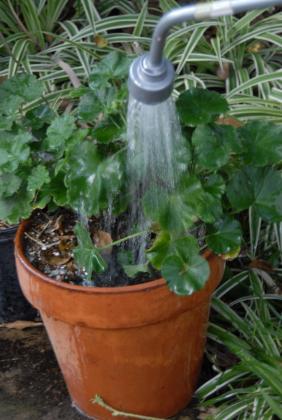
By Dan Gill
LSU AgCenter
Horticulturist
Summer is the time when people commonly take their longest vacations. When planning a vacation, people make arrangements to have someone take care of everything from the cat to the newspaper. But many neglect to have someone look after their plants and home grounds during their absence. If you’re going to be away from home for more than a week, you may return to find substantial damage has occurred to plants left unattended.
This is especially true for plants growing in containers — both indoors and outside. The ideal solution is to ask a friend who is knowledgeable about plants to check on your plants regularly and water them when necessary. Be sure to give written instructions on the needs of each plant because your friend may not be as familiar with them as you are. Try not to make the instructions too complicated, though.
If the plants are going to be on their own, however, move indoor plants away from sunny, bright windows so they use water less rapidly. This doesn’t mean putting them in a dark room, however; they still need bright, indirect light to stay healthy while you’re gone. Right before leaving on your trip, thoroughly water all of your indoor plants. Even allow some water to stand in the saucers beneath the plants’ containers — something we normally would not do.
Plants in small pots will tend to dry out the fastest. If you will be gone for more than a few days, enclose these plants (pot and all) in clear plastic bags to retain moisture and prevent drying out. Plants in plastic bags should receive bright light but no direct sun, which could cause excessive heat buildup inside the plastic.
Plants in containers outside need to be watered almost every day. Place all of your outdoor container plants, including any hanging baskets, in a shady location near the northern side of a building or under the protective cover of a large shade tree or covered patio. Group plants fairly close together as this, along with the shady location, will help slow water loss.
If you’ll be gone for more than a few days and you can’t find a someone to water for you, inexpensive water timers — available at local nurseries and hardware stores — can work very well hooked up to a sprinkler. A battery-operated or electrical unit attaches to an outside faucet. All you do is set the timer for when you want the water to come on (based on how often you generally have to water the plants) and for how long, and it will water your plants automatically.
It’s probably easier to use a sprinkler to water a grouping of your container plants. But if you want to be more sophisticated, drip systems are also available. An emitter head, which is attached to thin, plastic tubing, is placed into each container. When the water timer comes on, the tubing carries water to each container where the emitter allows the water to drip into the soil. This wastes very little water, but it takes more time and money to set up this type of system.
Water your home grounds well prior to leaving, especially if you’ve had little rainfall. A thorough, slow soaking will provide a lasting supply of moisture. Make sure you mulch all flower beds, vegetable gardens, shrub plantings and newly planted trees with a 2-to-3-inch layer of leaves, pine straw, cypress mulch or other available mulches to conserve moisture and hold down weeds.
Flower beds and vegetable gardens are particularly vulnerable to drought while you’re away. To water automatically, place either soaker hoses or sprinklers to cover various beds and areas of your landscape. Connect them to hoses attached to a timer at each faucet you use for irrigation. Set the timers to come on twice a week and stay on long enough to thoroughly soak an area. Also, set the times so that each water timer comes on at a different hour and you won’t lose water pressure while irrigating. Morning irrigation is best.
Be sure to mow and water the lawn before leaving, and plan to have it mowed during your absence if necessary. Most lawns require mowing at least every seven to 10 days. Besides becoming a tell-tale sign that you’re away, overgrowth is unhealthy for your lawn, and the grass will be unattractive and stressed when it finally is mowed.
Other things to do before you go
Harvest all ripe, near-ripe or harvestable-size vegetables to avoid waste and promote continued production. Consume, freeze or give the harvest away. Have someone check and regularly harvest vegetables such as okra, squash and cucumbers while you’re gone.
Thoroughly weed beds and make sure your mulch is at least 2 inches thick. Due to the rapid growth of weeds, a small problem can develop into a major disaster while you’re gone.
Be sure that walks and beds are neatly edged before you leave. This is another situation where the buildup of growth while you’re away will be difficult to manage when you return.
